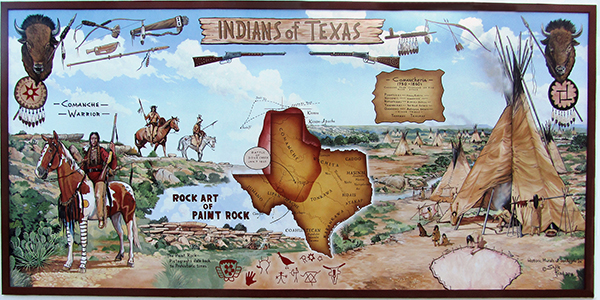|
The Indians of Texas Mural

40' wide x 18' high
The San Angelo area was in nearly constant upheaval as the more powerful Indian tribes fought viciously for control of the grasslands, rivers and hunting areas. So fierce was the fighting that even the Spanish settlers during the 1700s ventured away from the region so that their settlements could be more secure. Eventually, it was the Comanche who conquered the area, and their horse-riding warriors held control over the territory, which became known as Comancheria. The mural shows a large map of the Comanche and other Indian tribal areas across Texas.
There were once so many tribes that it would take another 40 feet of building to showcase them all. But luckily, just east of San Angelo and north of Paint Rock in Concho County is one of the longest lines of Indian rock art that can be still seen today. Hundreds of pictographs are painted on the limestone cliff located about 175 yards north of the river. There are an estimated 1,500 paintings spread out over a distance of a half mile. Geometric shapes, animal and human figures, and handprints in red, yellow, orange, black and white predominate. Stylle Read painted nearly a dozen examples of the pictographs in the lower center of this mural.
The Comanches were known for their large herds of horses and fierce warrior skills. The mural warriors are on horseback, with the spotted (pinto) horse in the foreground marked with the traditional black war paint stripes. Above the warriors and on the left and right of the mural, Read painted two buffalo heads, bows and arrows, a tomahawk, a lance, a ceremonial pipe and leather shields, all important parts of the Comanche war bundle. Western writers Ernest Wallace and E. Adamson Hoebel state in their book, "The Comanches: Lords of the South Plains," that next to his horse and his bow and arrows, the Comanche warrior's shield was his most important piece of equipment. It was believed that painted shields had spiritual power, and warriors would usually ask a tribal medicine man to craft a shield for them and decorate it with symbols that interpreted their individual dream visions.
Two types of war lances were used by the Comanche. One was shaped somewhat like a shepherd's crook while the other was straight. The shaft was six to seven feet long, usually made from wood and tipped with a head made from bone, flint or metal. Used for thrusting blows, only the bravest of the brave carried a war lance into hand-to-hand combat with the enemy.
During the Civil War and early 1865, one of the largest Indian battles ever to take place in Texas occurred on the shoreline of Dove Creek. A force of nearly 500 Confederate troops and county militia units made a desperate attack on an encampment of about 400 Kickapoo Indians. Unknown to the soldiers and militia, the Kickapoos did not want a confrontation with the Texans, but were better positioned and prepared for this sudden attack. The Battle of Dove Creek lasted about eight hours and resulted in the deaths of around 30 Texans and likely 15-20 Kickapoos. It was a bad defeat for the Texans that led to sustained hostility between the Kickapoo and area settlers.
The Comanches were typically nomads, making it difficult for government officials to make treaties or even local agreements with their decentralized group leadership. However, when Texas was officially annexed into the Union on Dec. 29, 1845, this situation changed significantly. The Comanche had to learn that the Americans and Texans were united and they could no longer rob from one and sell to the other. The U.S. Army built forts along the border and began to enforce and maintain some semblance of peace in the area. The numbers of settlers migrating into Texas rose rapidly, and the state's population tripled between 1850 and 1860.
The country west of San Antonio, Austin, and Dallas filled up with settlers, and the new Army forts attracted settlements that sprang up near them. All of these changes brought new challenges and opportunities to the Indians of Texas.
|



